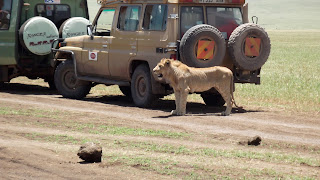I hope you all had wonderful, blessed Easters and are now ready to go back to work. I’m kind of like the girl in the cartoon and want another holiday between Easter and Memorial day. It’s too long to wait!
Today I want to comment more on the Wildebeests. These animals are said to be ugly; legend has it that God created them with the parts left over after he created all the others. But I don’t think so. They are really beautiful in their constant motion. Modern medical scientists should love them, they are so skinny!
Their constant activity, always running, keeps them all thin. I don’t know if that keeps them “young” and healthy. There are few old ones as they slow down when they get old and become “lion food”.
Most of you have seen the Great Migration on Animal Channel or National Geographic and loved the part where they crossed the river, unfortunately in that crossing, one or more of them is caught by an crock. We didn’t see that crossing, but we did watch thousands of them cross the trail right in front of our car.
A couple of days later we explored the Ngorongoro Crater. This volcanic caldera was formed millions of years ago when a no-longer active volcano floor collapsed. The 2,000 foot high walls isolate this 100 square miles from the Serengeti but it contain thousands of animals. Some call it the African Garden of Eden, but what ever you call it, it is truly God’s personal zoo! The floor is filled with grasses except for Lake Magadi which is pink with flamingos. Elephants, lions, gazelles, buffalo, zebra and wildebeests are plentiful and are accustomed enough to vehicles that they did not run away when we approached. Below is a lion standing behind the vehicle in front of us. Know that we do not have a long lens camera. These pictures are taken with a small e-camera. We stayed in our land cruiser!
We stayed in our land cruiser!
The thing I noticed about the wildebeests in the Crater, is that they were not thin, and did not run all the time. They had plenty of grass to eat all year around and no need to migrate even if they could get out of the Crater. Our guide said that some very dry years the grass dries up and many of them do climb out along a narrow, steep slope. Those of us who are more teleological might be tempted to say this is a natural way of thinning the herd.
In any event, the wildebeests in the crater and those outside have the same genetic make-up yet one herd is thin and the other is, not fat, but what we would call “just right”. Those outside the crater run all the time, either in migration or, I suppose, to stay in shape while those inside do not need to migrate or stay in shape and could not be seen as hyperactive.
Transferring these observations to human behavior leads me to think that ADHD in animals and in humans is not hereditary, but must be environmental! What it is in the environment I don’t know. Could it be that some parents like the wildebeests ignore their kids? I don’t think so. I like to blame TV, as much of the research shows, but this does not sit will with me, as I was a hyperactive kid and I never saw TV until I went to college. One of my sons and several of my grand kids are hyperactive too. A couple of these grand kids watched lots of TV, but one rarely watched. I don’t remember how my parents treated me before I started school, but I know my son was not treated like a wildebeest calf, and my grand kids were anything but ignored!
I learned in school that this type of anecdotal information makes terrible research with invalid results so I am left with a great explanation as to why wildebeests are hyperactive, but without a good reason for why some humans are hyperactive. Perhaps you can give me your thoughts.I would appreciate it.

